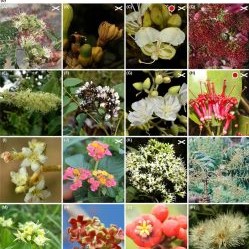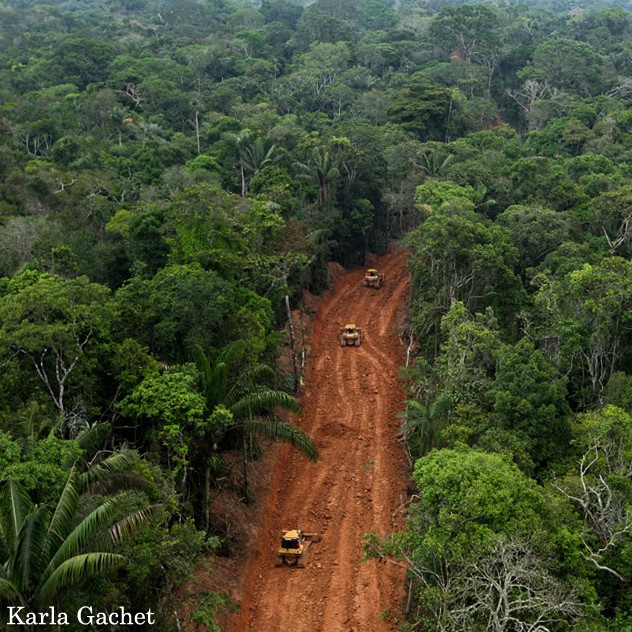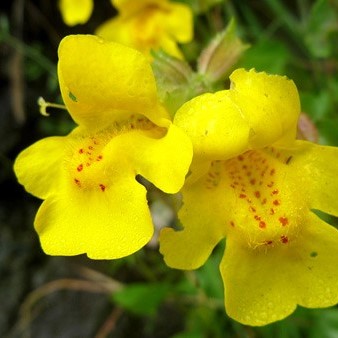Publications
Lai, H. R., Hill, T., Stivanello, S., & Chapman, H. M. (2025). Changes in quantity and timing of foliar and reproductive phenology of tropical dry‐forest trees under a warming and drying climate. Journal of Ecology. doi:10.1111/1365-2745.70044
Millar, A., & Chapman, H.M. (2025). Elevational differentiation occurs alongside high plasticity in a general-purpose genotype invasive plant. Journal of Ecology, 113(1), 220-231. doi:10.1111/1365-2745.14455
Abdulrahaman, A. O., Chapman, H.M., Tariq, A., Elias, P., Areh, M. O., Abdullah, Z. O., & Soufan, W. (2024). Multi-temporal analysis of forest canopy cover in Ngel Nyaki Forest Reserve using the Sentinel-1 and Sentinel-2 data. African Geographical Review. doi:10.1080/19376812.2024.2441680
Stivanello, T., Chapman, H.M., & Hill, T. (2024). Forest inventory and lightning strikes data from the Ngel Nyaki forest, Nigeria, 2018-2021.. NERC EDS Environmental Information Data Centre. (Dataset).. doi:10.5285/5237ab05-04bd-44b6-9c53-d21eb2083e39
Safavian, S., Briskie, J. V., Cameron, E., & Chapman, H.M. (2024). Disturbance by jet boating increases corticosterone concentrations in the black-backed gull (Larus dominicanus). New Zealand Journal of Zoology. doi:10.1080/03014223.2024.2420800
Williamson, M., Gerhard, D., Millar, A., Hulme, P., & Chapman, H. (2023). High-performing plastic clones best explain the spread of yellow monkeyflower from lowland to higher elevation areas in New Zealand.. Journal of Evolutionary Biology, 00, 1-16. doi:10.1111/jeb.14218
Chapman, H., & Abiem, I. (2022). Factors limiting plant recruitment in a Tropical Afromontane Forest. Biotropica. doi:10.1111/btp.13179
Williamson M., Gerhard D., Hulme P., Chapman, H. (2022) Relative roles of genetic variation and phenotypic plasticity in the invasion of monkeyflower Erythranthre gutatta in New Zealand BioRxiv
D Kenfack D, I Abiem, H Chapman The Efficiency of DNA Barcoding in the Identification of Afromontane Forest Tree Species Diversity 14 (4), 233
Hacket-Pain, A., Foest, J. J., Pearse, I. S., LaMontagne, J. M., Koenig, W. D., Vacchiano, G., . . . Ascoli, D. (2022). MASTREE+: Time-series of plant reproductive effort from six continents. Global Change Biology.
Islam, R., Howlett, B. G., Chapman, H., Haque, M. A., & Ahmad, M. (2022). The value of insect pollination to yield of oilseed rape (Brassica rapa) in Bangladesh. Journal of Asia-Pacific Entomology, 25(1).
Zhong, Y., Chu, C., Myers, J. A., Gilbert, G. S., Lutz, J. A., Stillhard, J., . . . Zimmerman, J. K. (2021). Arbuscular mycorrhizal trees influence the latitudinal beta-diversity gradient of tree communities in forests worldwide. Nature Communications, 12(1).
Tela, M., Cresswell, W., & Chapman, H. (2021). Assessment of Pest Control Services by Vertebrates in Nigerian Subsistence Maize Farms. Conservation and Society, 19(4), 218-224.
Jaafar, R., Yadok, B., Elisha, E., & Chapman, H. (2021). Grassland trees and the common bulbul Pycnonotus barbatus promote Afromontane forest restoration. Biotropica.
Cuni-Sanchez, A., Sullivan, M. J. P., Platts, P. J., Lewis, S. L., Marchant, R., Imani, G., . . . Willcock, S. (2021). High aboveground carbon stock of African tropical montane forests. Nature, 596(7873), 536-542.
Tela, M., Cresswell, W., & Chapman, H. (2021). Pest-removal services provided by birds on subsistence farms in south-eastern Nigeria. PLoS ONE, 16(8 August).
Chapman, H., Agaldo, J., & Christianini, A. (2021). Interactions between ants and non-myrmecochorous diaspores in a West African montane landscape. Journal of Tropical Ecology. PDF here
Cheek, M., Onana, J. M., & Chapman, H. M. (2021). The montane trees of the Cameroon Highlands, West-Central Africa, with Deinbollia onanae sp. Nov. (Sapindaceae), a new primate-dispersed, Endangered species. PeerJ, 9.
Nsor, C. A., Chapman, H., Godsoe, W., & Aliyu, A. H. (2021). Floral resources of key agromontane tree species predict sunbird distribution and abundance in Ngel Nyaki Forest, Taraba State-Nigeria. Greener Journal of Biological Sciences, 11(2), 81-92. Retrieved from http://gjournals.org/GJBS
Ostertag, R., Restrepo, C., Dalling, J. W., Martin, P. H., Abiem, I., Aiba, S. I., . . . Williams, C. B. (2021). Litter decomposition rates across tropical montane and lowland forests are controlled foremost by climate. Biotropica.
Davies, S. J., Abiem, I., Abu Salim, K., Aguilar, S., Allen, D., Alonso, A., . . . Muller-Landau, H. C. (2021). ForestGEO: Understanding forest diversity and dynamics through a global observatory network. Biological Conservation
Abiem, I., Dickie, I., Kenfack, D., & Chapman, H. (2021). Conspecific negative density dependence does not explain coexistence in a tropical Afromontane forest. Journal of Vegetation Science, 32(1).
Goldson, S. L., Barker, G. M., Chapman, H. M., Popay, A. J., Stewart, A. V., Caradus, J. R., & Barratt, B. I. P. (2020). Severe Insect Pest Impacts on New Zealand Pasture: The Plight of an Ecological Outlier. Journal of insect science (Online), 20(2).
Goldson, S. L., Barker, G. M., Chapman, H. M., Popay, A. J., Stewart, A. V., Caradus, J. R., & Barratt, B. I. P. (2020). Severe Insect Pest Impacts on New Zealand Pasture: The Plight of an Ecological Outlier. Journal of Insect Science, 20(2).
Yadok, B, Forget, PM, Gerhard D, Chapman HM 2020 Seed nutrient content rather than size influences seed dispersal by scatterhoarding rodents in a West African montane forest. Journal of Tropical Ecology
I Abiem, G Arellano, D Kenfack, H Chapman – Afromontane Forest Diversity and the Role of Grassland-Forest Transition in Tree Species Distribution Diversity 12 (1), 30
Yadok, B. G., Pech, R., & Chapman, H. (2019). Perception of predation risk by African giant pouched rats (Cricetomys sp. nov) is higher in forest-edge microhabitats. Behavioural Processes, 168.
Yadok, B. G., Forget, P. M., Gerhard, D., & Chapman, H. (2019). Low fruit-crop years of Carapa oreophila drive increased seed removal and predation by scatterhoarding rodents in a West African forest. Acta Oecologica, 99.
Chu, C., Lutz, J. A., Král, K., Vrška, T., Yin, X., Myers, J. A., . . . He, F. (2019). Direct and indirect effects of climate on richness drive the latitudinal diversity gradient in forest trees. Ecology Letters, 22(2), 245-255.
Nsor, C. A., Godsoe, W., & Chapman, H. M. (2019). Promiscuous pollinators—Evidence from an Afromontane sunbird–plant pollen transport network. Biotropica, 51(4), 538-548. https://www.youtube.com/watch?v=dl3sVFeoxqs
Charles, L. S., Dwyer, J. M., Chapman, H. M., Yadok, B. G., & Mayfield, M. M. (2019). Landscape structure mediates zoochorous-dispersed seed rain under isolated pasture trees across distinct tropical regions. Landscape Ecology, 34(6), 1347-1362.
Aliyu, B., Thia, J., Moltchanova, E., Forget, P. -M., & Chapman, H. M. (2018). Forest disturbance and seasonal food availability influence a conditional seed dispersal mutualism. Biotropica, 50(5), 750-757.
Arroyo, D., Hale, M., Blackburn, D., & Chapman, H. M. (2018). Conservation genetics of two threatened frogs from the Mambilla highlands, Nigeria. PLoS ONE.
Adewoye, R., & Chapman, H. M. (2018). Mapping deforestation patterns with time series MODIS data and BFAST algorithm. Journal of forest research and management, 15(1), 22-35.
Yadok, B. G., Gerhard, D., Forget, P. -M., & Chapman, H. M. (2018). Size doesn’t matter: Larger carapa seeds are not dispersed farther by African rodent community. African Journal of Ecology, 56.
Umar, D. M., Harding, J. S., & Chapman, H. M. (2018). Food Web Structure in Tropical Highland Stream Ecosystem. Greener Journal of Biological Sciences, 8(3), 29-41. Retrieved from http://www.gjournals.org/GJBS/archive/vol-8-3-july-2018.html
Osinubi, S., Brown, J., Briskie, J., & Chapman, H. (2018). Carotenoid-based plumage pigmentation and concentration as a function of sex and habitat type in the Yellow-breasted Boubou Laniarius atroflavus. Ostrich: Journal of African Ornithology, 49(2).
Aliyu, B., Thia, J., Moltchanova, E., Forget, P. -M., & Chapman, H. M. (2018). Forest disturbance and seasonal food availability influence a conditional seed dispersal mutualism. Biotropica, 50(3), 1-8.
Adewoye, R., & Chapman, H. M. (2018). Testing spectral variation hypothesis on the Afromontane forest ecosystem of Ngel Nyaki, north eastern Nigeria with landsat 8 (oli) and macro-ecological data. Journal of Forestry Research and Management, 15(1), 145-161.
Umar, D. M., Harding, J. S., & Chapman, H. M. (2017). Response of benthic invertebrate communities to a land use gradient in tropical highland streams in Nigeria. Tropical Freshwater Biology, 26, 53-77.
Mahmoud, M. I., Sloan, S., Campbell, M. J., Imong, I., Alamgir, I., Chapman, H. M., . . . Laurance, W. F. (2017). Alternative Routes for a Proposed Nigerian Superhighway to Limit Damage to Rare Ecosystems and Wildlife. TROPICAL CONSERVATION SCIENCE, 10, 1-10.
Umar, D., Harding, J. S., & Chapman, H. (2017). Riparian land use and the relationship between invertebrate communities and litter decomposition in a tropical highland stream. Nigeria Journal of Fisheries, 14, 1093-1107.
Walters, M., Knight, A., Chapman, H. M., Kraberger, S., Stainton, D., Varsani, A., . . . Christopher, A. (2017). Novel single-stranded DNA virus genomes recovered from chimpanzee feces sampled from the Mambilla Plateau in Nigeria. American Society for Microbiology, 5(9), e01715-e01716.
Nsor, C. A., Chapman, H. M., & Godsoe, W. (2017). Does a species’ extinction-proneness predict its contribution to nestedness? A test using a sunbird-tree visitation network. PLoS ONE, 12(1).
Chapman, H., Cordeiro, N. J., Dutton, P., Wenny, D., Kitamura, S., Kaplin, B., . . . Lawes, M. J. (2016). Seed-dispersal ecology of tropical montane forests. Journal of Tropical Ecology, 32(5), 437-454.
Thia, J. A., Hale, M. L., Stouffer, D. B., & Chapman, H. M. (2016). Limited dispersal into appropriate microhabitats likely explains recruitment failure in a chimpanzee-dependent tree species. African Journal of Ecology, 54(1), 121-124.
J. A., Hale, M. L., & Chapman, H. M. (2016). Interspecific comparisons with chloroplast SSR loci reveal limited genetic variation in Nigerian montane forests: A study on Cordia millenii (West African Cordia), Entandrophragma angolense (tiama mahogany), and Lovoa trichilioides (African walnut). Tropical Conservation Science, 9(1), 321-337.
Dutton, P., Moltchanova., & Chapman, H. M. (2016). Nesting Ecology of a Small Montane Population of the Nigerian/Cameroon Chimpanzee (Pan troglodytes ellioti) in Nigeria. Fola Primatologica, 87(6), 361-374.
Knight, A., Chapman, H. M., & Hale, M. (2016). Habitat fragmentation and its implications for Endangered chimpanzee Pan troglodytes conservation. Oryx, 50(3), 533-536.
Grassham, A. M., Kunz, B. K., Goldson, S. L., Bawaro, M., & Chapman, H. M. (2015). Seed Dispersal by the Tantalus Monkey, Chlorocebus tantalus: Implications for Forest Restoration and Expansion within an Afromontane Landscape in Nigeria. African Primates, 10, 13-24.
Adewoye, R., Huettich, C., Schmullius, C., & Chapman, H. M. (2015). Estimating Aboveground Biomass of the Afromontane Forests of Mambilla Plateau Using Quickbird and in Situ Forest Inventory Data. Journal of Remote Sensing Technology, 3, 1-8.
Dutton, P., & Chapman, H. M. (2015). Dietary preferences of a submontane population of the rare Nigerian-Cameroon chimpanzee (Pan troglodytes ellioti) in Ngel Nyaki Forest Reserve, Nigeria. American Journal of Primatology, 77(1), 86-97.
Van Vianen, J. C. C. M., Houliston, G. J., Fletcher, J. D., Heenan, P. B., & Chapman, H. M. (2015). Consequences of interspecific hybridization and virus infection on the growth and fecundity of three threatened coastal Lepidium (Brassicaceae) species from New Zealand. Austral Ecology, 40(6), 672-682.
Dutton, P. A., & Chapman, H. M. (2015). New tools suggest local variation in tool use by a montane community of the rare Nigeria-Cameroon chimpanzee, Pan troglodytes ellioti, in Nigeria. Primates, 56(1), 89-100.
Barnes, A. D., & Chapman, H. M. (2014). Dispersal traits determine passive restoration trajectory of a Nigerian montane forest. Acta Oecologica, 56, 32-40.
Barnes, A. D., Emberson, R. M., Chapman, H. M., Krell, F. -T., & Didham, R. K. (2014). Matrix habitat restoration alters dung beetle species responses across tropical forest edges. Biological Conservation, 170, 28-37.
Umar, D. M., Harding, J. S., & Chapman, H. M. (2014). Tropical land use and its effects on stream communities. Journal of Environmental Sciences and Policy Evaluation, 4(2), 165-196.
Aliyu, B., Adamu, H., Moltchanova, E., Forget, P. M., & Chapman, H. M. (2014). The interplay of habitat and seed type on scatterhoarding behaviour in a fragmented Afromontane forest landscape. Biotropica, 46(3), 264-267.
Dutton, P. E., Chapman, H. M., & Moltchanova, E. (2014). Secondary Removal of Seeds Dispersed by Chimpanzees in a Nigerian Montane Forest. African Journal of Ecology, 52(4), 438-447.
Barnes, A. D., Emberson, R. M., Chapman, H. M., Frank, T., Krell, K. T., & Didham, R. K. (2014). Matrix habitat restoration alters dung beetle species responses across tropical forest edges. Biological Conservation, 170, 28-37.
Barnes, A. D., & Chapman, H. M. (2014). Dispersal traits determine passive restoration trajectory of a Nigerian montane forest. Acta Oecologia, 56, 32-40.
Osinubi, S. T., Vugeh, Y., Briskie, J. V., Ottosson, U., Brown, J. A., & Chapman, H. M. (2014). Association with riparian fragments by Yellow-breasted Boubou Laniarius atroflavus indicates need for wider-scale forest matrix conservation. Malimbus, 36(1), 47-57.
van Vianan, J. C. C. M., Houliston, G. J., Fletcher, J. D., Heenan, P. B., & Chapman, H. M. (2013). New threats to endangered Cook’s scurvy grass (Lepidium oleraceum; Brassicaceae): introduced crop viruses and the extent of their spread. Australian Journal of Botany, 61(2), 161-166.
Nsor, C., & Chapman, H. M. (2013). A preliminary investigation into the avian pollinators of three tree species in a Nigerian montane forest. Malimbus, 35, 37-49.
Umar, D. M., Marinov, M. G., Schorr, M., & Chapman, H. M. (2012). Odonata attracted by light: A new topic for myth-busters. International Dragonfly Fund Report, 43, 1-52.
Weston, K. A., Chapman, H. M., Kelly, D., & Moltchanova, E. V. (2012). Dependence on sunbird pollination for fruit set in three West African montane mistletoe species. Journal of Tropical Ecology, 28(02), 205-213. doi:10.1017/S026646741100068X
Beavon, M. A., & Chapman, H. M. (2011). Andromonoecy and high fruit abortion in Anthonotha noldeae in a West African montane Forest. Plant Systematics and Evolution, 296(3-4), 217-224.
Ihuma, J. O., Chima, U. D., & Chapman, H. M. (2011). Tree species diversity in a Nigerian montane forest ecosystem and adjacent fragmented forests. ARPN Journal of Agricultural and Biological Science, 6(2), 17-22.
Matthesius, A., Chapman, H., & Kelly, D. (2011). Testing for Janzen-Connell Effects in a West African Montane Forest. Biotropica, 43(1), 77-83.
Ihuma, J. O., Chapman, H. M., & Chima, U. D. (2011). Recruitment of woody plant species juveniles in Ngel Nyaki Forest Reserve and its potential for forest regeneration. International Journal of Science and Nature, 2(4), 718-722.
Ihuma, J., Chapman, H. M., Tella, I., Akosim, C., & Goldson, S. L. (2011). Guild of frugivores on three fruit producing species (Polyscius fulva, Syzygium guineensis and Pouteria altissima) in Ngel Nyaki forest Reserve, a montane Forest Ecosystem in Nigeria. Journal of Research in Forestry, Wildlife and Environment, 3(1), 1-3.
Ihuma, J. O., Chima, U. D., & Chapman, H. M. (2011). Diversity of fruit trees and frugivores in a nigerian montane forest and adjacent fragmented forests. International Journal of Plant, Animal and Environmental Sciences, 1(2), 6-15.
Agmen, F. L., Chapman, H. M., & Bawuro, M. (2010). Seed dispersal by tantalus monkeys (Chlorocebus tantalus tantalus) in a Nigerian montane forest. African Journal of Ecology, 48(4), 1123-1128.
Chapman, H. M., Goldson, S. L., & Beck, J. (2010). Postdispersal removal and germination of seed dispersed by Cercopithecus nictitans in a West African Montane Forest. Folia Primatologica, 81(1), 41-50.
Morgan-Richards, M., Smissen, R. D., Shepherd, L. D., Wallis, G. P., Hayward, J. J., Chan, C. H., . . . Chapman, H. M. (2009). A review of genetic analyses of hybridisation in New Zealand. Journal of the Royal Society of New Zealand, 39(1), 15-34.
Darbyshire, I., Vollesen, K., & Chapman, H. M. (2008). A remarkable range disjunction recorded in Metarungia pubinervia (Acanthaceae). Kew Bulletin, 63(4), 613-615.
Beck, J., & Chapman, H. (2008). A population estimate of the Endangered chimpanzee Pan trolodytes vellerosus in a Nigerian montane forest: implications for conservation. Fauna & Flora International, 42(3), 448-451.
Chapman, H. (2008). The Nigerian montane forest project. Tropinet, 19(1), 7-9.
Houliston, G. J., Chapman, H. M., & Bicknell, R. A. (2006). The influence of genotype and environment on the fecundity and facultative expression of apomixes in Hieracium pilosella. Folia Geobotanica, 41(2), 165-181.
Chapman, H. M., Olson, S., & Trumm, D. (2004). A report on the montane forests of Taraba State Nigeria, and an assessment of how have they changed over the past thirty years. Oryx, 38(3), 282-290.
Chapman, H. M., & Robson, B. (2004). Population genetic structure of a colonizing, triploid weed, Hieracium Lepidulum. Heredity, 92, 182-188.
Houliston, G., & Chapman, H. M. (2004). Reproductive strategy and population variability in the facultative apomict Hieracium pilosella (Asteraceae). American Journal of Botany, 91(1), 37-44.
Trewick, S., Morgan-Richards, M., Chapman, H. M., & Krahulcova, A. (2004). Chloroplast DNA diversity of Hieracium pilosella (Asteraceae) introduced to New Zealand: reticulation, hybridization and invasion. American Journal of Botany, 91, 73-85.
McCall, A. C., Kelly, D., & Chapman, H. C. (2004). Little geographic or host plant genetic variation in a Chionochloa (Poaceae) seeds predator (Cecidomyiidae: undescribed species). New Zealand Journal of Ecology, 28(2), 215-224.
Chapman, H. M., Olson, S., & Trumm, D. (2004). A report on the montane forests of Taraba State Nigeria, and an assessment of how have they changed over the past thirty years. Oryx, 38(3), 282-290.
Chapman, H., Houliston, G. J., Robson, B., & Iline, I. (2003). A Case of Reversal: The Evolution and Maintenance of Sexuals from Parthenogenetic Clones in Hieracium pilosella. International Journal of Plant Sciences, 164(5), 719-728.
Chapman, H., Pearson, M. L., & Robson, B. (2003). Genetic diversity in tussock hawkweed (Hieracium lepidulum) and use of allelic frequencies for identifying patterns of spread. DOC Science Internal Series, (109), 19pp.
Phillips, C. B., Cane, R. P., Mee, J., Chapman, H. M., Hoelmer, K. A., & Coutinot, D. (2002). Intraspecific variation in the ability of Microctonus aethiopoides (Hymenoptera: Braconidae) to parasitise Sitona lepidus (Coleoptera: Curculionidae). New Zealand Journal of Agricultural Research, 45(4), 295-303.
Chapman, H., & Brown, J. (2001). Thawing’ of ‘frozen’ variation in an adventive, facultatively apomictic, clonal weed. Plant Species Biology, 16(2), 107-118.
Houliston, G., & Chapman, H. M. (2001). Sexual reproduction in field populations of the facultative apomict, Hieracium pilosella. New Zealand Journal of Botany, 39, 141-146.
Chapman, H. M., Parh, D., & Oraguzie, N. (2000). Genetic structure and colonising success of a clonal weedy species, Pilosella officinarum (Asteraceae). Heredity, 84(4), 401-409.
Chapman, H. M., & Bicknell, R. (2000). Recovery of a sexual and an apomictic hybrid from crosses between the facultative apomicts Hieracium caespitosum and H. praealtum. New Zealand Journal of Ecology, 24, 81-86
Kraholcova, A., Kraholec, F. F., & Chapman, H. M. (2000). Variation in Hieracium subjen, Pibsella (Asteraccae): What do we know about its sources?. Folia Geobotanica, 35, 319-338.
Mitchell, A., Hogan, K., & Chapman, H. M. (1999). Genetic variation in Aciphylla glaucescens (Apiaceae). New Zealand Journal of Ecology, 23(1), 61-67.
Rowarth, J. S., Chapman, H. M., & Novis, P. (1998). Water stress and seed yield in perennial ryegrass (Lolium perernne L.) grown in pits. Journal of Applied Seed Production, 15, 89-92.
Oraguzie, N. C., McNeil, D. L., Paterson, A. M., & Chapman, H. M. (1998). Comparison of RAPD and MorphoNut markers for revealing genetic relationships between chestnut species (Castanea spp) and New Zealand chestnut selections. New Zealand Journal of Crop and Horticultural Science, 26(2), 109-115.
Abbott, R. J., Chapman, H. M., & Forbes, D. (1995). Molecular diversity and derivations of populations of Silene acaulis and Saxifraga oppositifolia from the high Arctic and more southerly latitudes. Molecular Ecology, 4(2), 199-208.
Chapman, H. M., & Bannister, P. B. (1995). Flowering, shoot extension, and reproductive performance of heather, Calluna vulgaris (L). Hull, in Tongariro National Park, New Zealand. New Zealand Journal of Botany, 33(1), 111-119.
Crawford, R. M. M., Chapman, H. M., & Smith, L. C. (1995). Adaptation to variation in growing season length in Arctic populations of Saxifraga oppositifolia L. Botanical Journal of Scotland, 47(2), 177-192.
Chapman, H. M., & Bannister, P. B. (1994). Vegetative Production and Performance of Calluna vulgaris in New Zealand, with Particular Reference to Tongariro National- Park. New Zealand Journal of Ecology, 18(2), 109-121.
Crawford, R. M. M., Chapman, H. M., & Hodge, H. (1994). Anoxia tolerance in high Arctic vegetation. Arctic and Alpine Research, 26(3), 308-312.
Crawford, R. M. M., Chapman, H. M., Balfour, J., & Abbott, R. J. (1993). Potential impact of climatic warming on Arctic vegetation. Flora, 188, 367-381.
Chapman, H. M., & Bannister, P. B. (1990). The spread of heather, Calluna vulgaris (L.) Hull, into indigenous plant communities of Tongariro National Park, New Zealand. New Zealand Journal of Ecology, 14, 7-16.
Chapman, H. M., Dodds, K. G., & Keoghan, J. M. (1990). Evaluation of the agronomic potential of pasture legume introductions on droughty outwash soils. New Zealand Journal of Agricultural Research, 33(1), 21-28.
Podcast Interviews
News Articles



